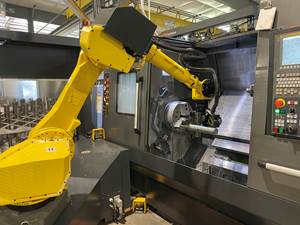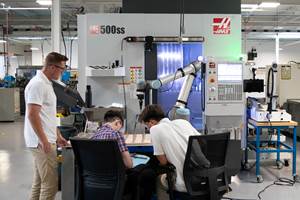Short Bar Loader Helps Job Shop Meet Tolerance Specs And Throughput Goals
Maintaining high accuracy and repeatability in production parts requires precision workholding systems as well as precision machine tools. To help machine a particularly complex, high volume part, the company has installed magazine short bar load systems to complement production lathes.
Share





Pushing the limits of conventional machining technology is the norm at Instrument Development Corporation (Mukwonago, Wisconsin).
IDC is a 50-person job shop that specializes in the production of close tolerance automotive parts and aerospace components, such as guidance and navigation system components with complex geometries and precision control valves.
Today, IDC operates a range of turning machines and auxiliary equipment, and specializes in handling a variety of materials including exotic stainless steels, titanium, precious metals, tungsten and aluminum.
"We're set up to produce large runs of highly complex parts from difficult to machine materials to very close tolerances, usually tenths all over," said Kevin Sinnett, IDC owner and CEO.
Maintaining high accuracy and repeatability in production parts requires precision workholding systems as well as precision machine tools. To help machine a particularly complex, high volume part, the company has installed magazine short bar load systems to complement production lathes.
The part is a 1-inch diameter aluminum variable frequency solenoid body used to regulate pressure in an automobile transmission. The nozzle, as it is called, has a 1/4-inch bore that requires a 0.0003 inch tolerance to accommodate a high-speed spool. It also requires 12 drilled holes and a multi-faceted outside diameter with O-ring grooves. Since the timing of the solenoid body is controlled by the hole positions, maintaining tight tolerances during production is critical.
Part production is continuous. The lathes are in operation 24 hours per day, six days a week, producing 6,000 pieces per day.
"Generally, we'd use a standard 12-foot aluminum bar for this type of production operation, but because of the close tolerances we had to use a shorter bar length," Mr. Sinnett said. "When you try to run a 12-foot bar at 6,000 to 7,000 rpm, the vibration makes it difficult to hold tight tolerances, plus, over time, it can destroy a machine tool."
This problem caused the company to look for a better way to do things. IDC decided to install five "Multifeed" magazine short bar loaders from Lexair, Inc. (Lexington, Kentucky) to overcome the bar vibration problem. These compact, fully automatic bar loaders have a much smaller footprint than conventional bar feeders and can handle bar diameters from 1/8 inch to 3 1/8 inches and lengths up to 60 inches.
At IDC, 1-inch diameter, 12-foot aluminum bars are cut into four 36-inch lengths and loaded into the magazine, which has a capacity of 36 1-inch diameter bars. Bar straightness is not critical to system operation, and no bar end machining is required prior to loading, only deburring.
The Multifeed system features a remote hand-held pendant control for set up in as little as two to three minutes. It also comes standard with a swing out mechanism, allowing the bar feed to be moved out of the way for lathe maintenance, without losing the alignment to the lathe. The push rod partially retracts from the bar as the collet closes, reducing the possibility of vibration during the turning operation. There is no rpm limit with the system.
In operation, the insert pusher inserts stock into the lathe. As the pusher retracts, the bar loader's cross slide changes position in about two seconds so that the push rod is in line with the lathe and pushes the bar through the collet. During the turning process, the next bar in the magazine is simultaneously loaded into the insertion channel. When "end of bar" is reached, the lathe stops and the bar end is ejected. The push rod retracts at high speed, the cross slide moves over, and the next bar in the channel is inserted into the lathe. When stock has been depleted from the magazine, the main pusher retracts after ejecting the last end. The cross slide moves out and the controller forces a safe condition and signals that the magazine is empty.
The company found that the Multifeed system has a fast next bar insert and start time of about 10 seconds, keeping the part cycle time at 107 to 108 seconds.
The Multifeed system is designed to interface with most CNC lathes including Hardinge Conquest GT and Wasino LG-6 CNC flat slide gang tool lathes.
"The 1-inch diameter bar is the same as the draw tube on the collet," Mr. Sinnett said, "so we are able to operate the bar feeders without a liner."
Lexair's master spindle reduction liner, available as an option, prevents whip while running a short bar at maximum rpm. This master liner, combined with a set of customer supplied bushings, handles most bar sizes without the need to purchase separate spindle reduction liners for each bar size used.
The first Multifeed bar loaders at IDC were installed about one and a half years ago, and they have been in continuous operation ever since.
Related Content
Same Headcount, Double the Sales: Successful Job Shop Automation
Doubling sales requires more than just robots. Pro Products’ staff works in tandem with robots, performing inspection and other value-added activities.
Read MoreCNC Machine Shop Honored for Automation, Machine Monitoring
From cobots to machine monitoring, this Top Shop honoree shows that machining technology is about more than the machine tool.
Read MoreUsing Automation to Reduce COGS and Stay Globally Competitive
Decade-long, multiphase automation investments lower operating costs and maintain technology lead in an increasingly competitive global market.
Read MoreStuder's Automation, Entry-Level Solutions Take Center Stage
At its 2024 Music Motion Meeting, Studer AG showed off its entry-level line of grinding machines, as well as its newest universal loading system.
Read MoreRead Next
Machine Shop MBA
Making Chips and 91ÊÓƵÍøÕ¾ÎÛ are teaming up for a new podcast series called Machine Shop MBA—designed to help manufacturers measure their success against the industry’s best. Through the lens of the Top Shops benchmarking program, the series explores the KPIs that set high-performing shops apart, from machine utilization and first-pass yield to employee engagement and revenue per employee.
Read MoreAMRs Are Moving Into Manufacturing: 4 Considerations for Implementation
AMRs can provide a flexible, easy-to-use automation platform so long as manufacturers choose a suitable task and prepare their facilities.
Read More




















